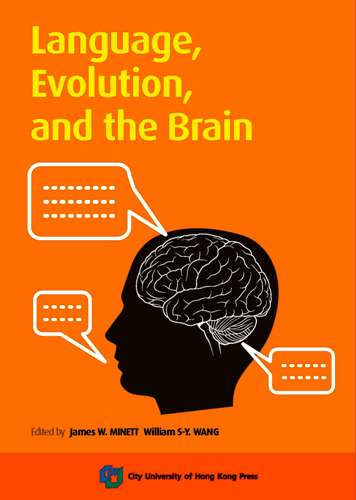Homepage
Home
Prof. William S.Y. Wang and Dr. James W. Minett have recently published a new book titled “Language, Evolution, and the Brain”.
This volume consists of an important collection of papers presented at the Seminar on Language, Evolution, and the Brain (SLEB), hosted by the International Institute for Advanced Studies in Kyoto, Japan, bringing together distinguished researchers with backgrounds in cognitive science, anthropology, linguistics, robotics, physics, etc. Major topics discussed include:
- Creoles and pidgins, and their implications regarding language evolution.
- Quantitative analysis and modeling of various aspects of language evolution, including the evolution of lexical items and color terms, the emergence of linguistic categories, and the dynamics of language competition.
- The evolution of the human brain, and how that relates to language evolution.
- The evolution and role of mirror neurons in both humans and non-humans.
- Evidence that the influence of language on color perception (an example of the Whorf Effect) is stronger for the right visual field than the left.

Prof. J.B. Xu has secured the Joint Research Fund for Overseas Chinese, Hong Kong and Macao Young Scholars and will have 200,000 RMB for the first two years, afterwards fundable for another 1.2 million RMB, subject to a second review. The fund, which is nationally a prestigious award for young scientists, formerly named as "National Science Fund for Distinguished Young Scholars", Class B. Ironically, its Chinese acronym-name is JB.
In 2009 round, there are 77 awardees nation-wide, 33 from life sciences, 44 shared among physical sciences, chemistry, information sciences, earth sciences, and materials and engineering sciences.
The detailed information about the Joint Fund can be found at the NSFCwebsite: http://www.nsfc.gov.cn
Led by Prof. Li Quan of the Physics Department and Prof. Xu Jianbin of the Electronic Engineering Department, the research team at The Chinese University of Hong Kong (CUHK) revealed a breakthrough in semiconductors. It opens up a new front in semiconductor physics and nanotechnology, and holds promise to take the development of computer technology to new heights with faster computing speed and larger data storage capacity, but less power consumption.
The press release has been issued to the media and posted on the University website. Here are the links for your information:
http://www.cuhk.edu.hk/cpr/pressrelease/090719c.htm(Chinese)
http://www.cuhk.edu.hk/cpr/pressrelease/090719e.htm(English)
Paper submitted by Prof. C.T. Shu was accepted by Top Class OFC Conference postdeadline.
Paper submitted by This email address is being protected from spambots. You need JavaScript enabled to view it. in Opto-electronic Research Lab., was accepted postdeadline in the world class OFC Conference in San Diego.
As quoted from Prof H.K. TSANG, a renowned researcher in the area :
"I wish to extend my congratulations to Chester for getting his postdeadline paper accepted at OFC here in San Diego. There were 117 postdeadline submissions and only 35 accepted. As OFC is the top optical communications conference in the world (thousands of attendees), it is an extremely difficult and rare achievement to get a postdeadline paper accepted at OFC particularly as only the most significant results are submitted for the postdeadline session - Chester deserves our congratulations for his success in bringing international recognition to CUHK for his work in optical signal processing."
The paper is entitled "Delay-asymmetric nonlinear loop mirror" authored by Dr. Mable P. Fok and Prof. Chester Shu. They demonstrate a new class of nonlinear optical fiber device that provides a unique solution to address the challenge of demodulating differential phase-shifted keying signals at variable bit-rates. The work will have a significant impact in ultrafast processing of optical communication signals.
Subcategories
Scholarship Received Article Count: 22
Professors and Research Staff Article Count: 132
Students Article Count: 159



